
The smooth green snake is a species of North American nonvenomous snake in the family Colubridae. The species is also referred to as the grass snake. It is a slender, "small medium" snake that measures 36–51 cm (14–20 in) as an adult. It gets its common name from its smooth dorsal scales, as opposed to the rough green snake, which has keeled dorsal scales. The smooth green snake is found in marshes, meadows, open woods, and along stream edges, and is native to regions of Canada, the United States, and northern Mexico. A non-aggressive snake, it seldom bites and usually flees when threatened. It mates in late spring to summer, and females lay their eggs from June to September. Smooth green snakes will often bob their heads in order to mimic vegetation blowing in the wind.
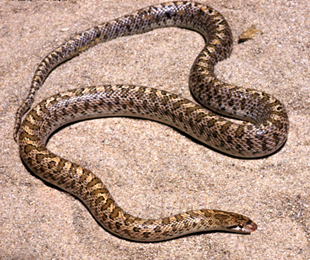
Arizona elegans is a species of medium-sized colubrid snake commonly referred to as the glossy snake or the faded snake, which is endemic to the southwestern United States and Mexico. It has several subspecies. Some have recommended that A. elegans occidentalis be granted full species status.

Opheodrys is a genus of small to medium-sized nonvenomous colubrid snakes commonly referred to as green snakes. In North America the genus consists of two distinct species. As their common names imply, the rough green snake has keeled dorsal scales, whereas the smooth green snake has smooth dorsal scales.

Tropidoclonion is a genus of snake in the subfamily Natricinae of the family Colubridae. The genus is monotypic, containing the sole species Tropidoclonion lineatum, commonly known as the lined snake. The species is endemic to North America.

Nerodia is a genus of nonvenomous colubrid snakes commonly referred to as water snakes due to their aquatic behavior. The genus includes nine species, all native to North America.

The Trans-Pecos rat snake or Davis Mountain rat snake, is a species of medium to large, nonvenomous rat snake in the family Colubridae. Bogertophis subocularis is endemic to the Chihuahuan Desert.

Diadophis punctatus regalis, commonly known as the regal ringneck snake, is a subspecies of ringneck snake endemic to the southwestern United States and northern Mexico.
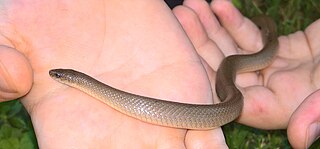
Haldea striatula, commonly called the rough earth snake, is a species of nonvenomous natricine colubrid snake native to the Southeastern United States.
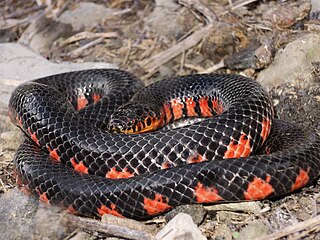
The mud snake is a species of nonvenomous, semiaquatic, colubrid snake endemic to the southeastern United States.

Agkistrodon contortrix mokasen was formerly a venomous pit viper subspecies found in the eastern United States. However, recent taxonomic changes do not recognize the northern copperhead as a valid taxon.

The crayfish snake, also known commonly as the glossy crayfish snake, the glossy swampsnake, the glossy water snake, and the striped water snake, is a species of semiaquatic snake in the subfamily Natricinae of the family Colubridae. The species is endemic to the southeastern United States, and preys mainly on crayfish.

Kirtland's snake is a threatened or endangered North American species of nonvenomous snake of the subfamily Natricinae, of the family Colubridae. It is the only species in the genus Clonophis.
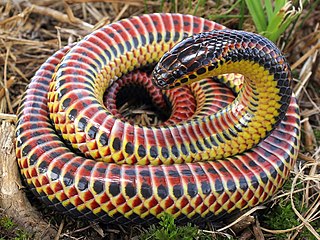
Farancia erytrogramma is a species of large, nonvenomous, highly aquatic, colubrid snake, which is endemic to coastal plains of the southeastern United States. Two subspecies are recognized as being valid, one of which has been declared extinct.

The southern ribbon snake(Thamnophis saurita sackenii), also known commonly as the peninsula ribbon snake and the Florida ribbon snake, is a subspecies of garter snake in the family Colubridae. It is one of four subspecies of the ribbon snake.
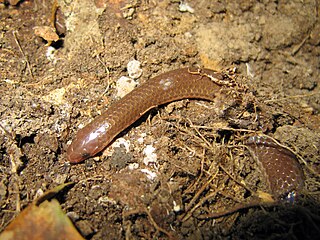
The eastern worm snake is a subspecies of the worm snake, Carphophis amoenus, a nonvenomous colubrid endemic to the Eastern Woodlands region of North America. The species' range extends from southwest Massachusetts, south to southern Alabama, west to Louisiana and north to Illinois. This species is common in the ecotone between woodlands and wetlands. It may also be found in grasslands adjacent to woodlands. Though this snake can be abundant in parts of its range, it is rarely seen because of its fossorial lifestyle. When not underground, C. a. amoenus resides mostly under rocks, logs and leaf litter, or burrowed within rotting woody debris. This snake is perfectly safe to pick up, as it cannot bite, but may produce a foul-smelling excretion.

Thamnophis proximus, commonly known as the western ribbon snake, is a species of garter snake in the subfamily Natricinae of the family Colubridae. The species is endemic to the western United States, Mexico, and Central America. The species has six recognized subspecies.
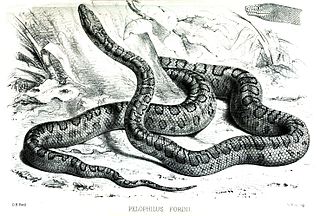
Chilabothrus fordii, known commonly as Ford's boa or the Haitian ground boa, is a species of snake in the family Boidae.

Chilabothrus gracilis is a species of nonvenomous snake in the Boidae family. It is endemic to Hispaniola.
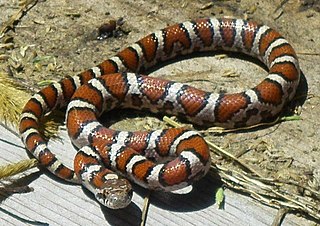
Lampropeltis triangulum triangulum, commonly known as the eastern milk snake or eastern milksnake, is a subspecies of the milk snake. The nonvenomous, colubrid snake is indigenous to eastern and central North America.

Carphophis amoenus, commonly known as the worm snake, is a species of nonvenomous colubrid snake endemic to the eastern United States. C. amoenus can be found east of the Mississippi, from southwest Massachusetts south to southern Alabama west to Louisiana and then north to Illinois. This species of snake protects a large range, and normally prefers a moist habitat in the rocky woodlands, under rotten wood of logs and stumps. Though this snake is quite abundant over its range, it is rarely seen because of its dormant lifestyle and where it usually resides. This snake is most common on the edges or in the ecotonal areas of open to thick woodlands, and the borders of wetlands. It may also be found in the grasslands next to woodlands. The best chance to spot it is after heavy rains, when its small size and distinct color make it easy to spot. This species prefers moist soil inhabited by earthworms, which are its main prey, so the soil needs to be sufficiently moist. The snake's skin naturally evaporates water; so the soil needs to be moist enough to offset this. C. amoenus is mostly found under rocks and in sufficient leaf litter during the extreme daytime heat.




















